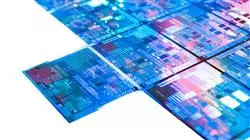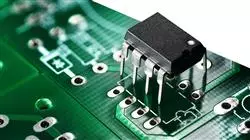University certificate
The world's largest faculty of engineering”
Introduction to the Program
Explore with this Postgraduate certificate the wide possibilities offered by the development of Applied Electronics in the field of Engineering”

The 20th century is technologically marked by analog electronic systems, which allowed the arrival of televisions in homes, video recorders, audio recorders or the first computers. However, the improvement of technology and tools has made possible the development of digital electronics. Thanks to it, there is now a higher quality of data and information storage.
The digital concept is already present in all economic sectors, including industry, which has been able to take advantage of each of the advances obtained to optimize productivity. This progress in turn has driven the need for engineering professionals with well-founded knowledge in this area, both for the design of new devices and to solve any technical problem in their equipment. That is why this academic institution has created this program, which offers the graduate the most essential information on circuits, systems, and components that make up the Analog and Digital Electronics.
A university program that will provide students with knowledge that will allow them to advance in their professional careers in just 6 weeks. For this purpose, it has a syllabus that provides a theoretical-practical approach in this field and is complemented with video summaries, detailed videos, specialized readings or case studies. All this is prepared by a teaching team specialized in electronics.
The professional is, therefore, facing an excellent opportunity to progress through a university education provided in a convenient and 100% online format. Students only need a computer, tablet, or cell phone with an Internet connection to access the content hosted on the Virtual Campus. In addition, thanks to the Relearning system, you will reduce the hours dedicated to memorization and will flow much more smoothly through this university education.
This program allows you to delve into logic functions and combinational circuits whenever you wish, from your computer"
This Postgraduate certificate in Analog and Digital Electronics contains the most complete and up-to-date program on the market. The most important features include:
- Practical case studies are presented by experts in Physics
- The graphic, schematic, and practical contents with which they are created, provide scientific and practical information on the disciplines that are essential for professional practice
- Practical exercises where the self-assessment process can be carried out to improve learning
- Its special emphasis on innovative methodologies
- Theoretical lessons, questions to the expert, debate forums on controversial topics, and individual reflection assignments
- Content that is accessible from any fixed or portable device with an Internet connection
Boost your professional career with a Postgraduate certificate that provides you with intensive learning on Analog and Digital Electronics”
The program’s teaching staff includes professionals from the sector who contribute their work experience to this educational program, as well as renowned specialists
from leading societies and prestigious universities.
The multimedia content, developed with the latest educational technology, will provide the professional with situated and contextual learning, i.e., a simulated environment that will provide immersive education programmed to learn in real situations.
This program is designed around Problem-Based Learning, whereby the professional must try to solve the different professional practice situations that arise during the academic year For this purpose, the students will be assisted by an innovative interactive video system created by renowned and experienced experts.
Become a much more competitive engineering professional by mastering Analog and Digital Electronics"

TECH adapts to you and that is why it has designed a 100% online Postgraduate certificate, with no fixed timetables and flexible schedules"
Why study at TECH?
TECH is the world’s largest online university. With an impressive catalog of more than 14,000 university programs available in 11 languages, it is positioned as a leader in employability, with a 99% job placement rate. In addition, it relies on an enormous faculty of more than 6,000 professors of the highest international renown.

Study at the world's largest online university and guarantee your professional success. The future starts at TECH”
The world’s best online university according to FORBES
The prestigious Forbes magazine, specialized in business and finance, has highlighted TECH as “the world's best online university” This is what they have recently stated in an article in their digital edition in which they echo the success story of this institution, “thanks to the academic offer it provides, the selection of its teaching staff, and an innovative learning method aimed at educating the professionals of the future”
A revolutionary study method, a cutting-edge faculty and a practical focus: the key to TECH's success.
The most complete study plans on the university scene
TECH offers the most complete study plans on the university scene, with syllabuses that cover fundamental concepts and, at the same time, the main scientific advances in their specific scientific areas. In addition, these programs are continuously being updated to guarantee students the academic vanguard and the most in-demand professional skills. In this way, the university's qualifications provide its graduates with a significant advantage to propel their careers to success.
TECH offers the most comprehensive and intensive study plans on the current university scene.
A world-class teaching staff
TECH's teaching staff is made up of more than 6,000 professors with the highest international recognition. Professors, researchers and top executives of multinational companies, including Isaiah Covington, performance coach of the Boston Celtics; Magda Romanska, principal investigator at Harvard MetaLAB; Ignacio Wistumba, chairman of the department of translational molecular pathology at MD Anderson Cancer Center; and D.W. Pine, creative director of TIME magazine, among others.
Internationally renowned experts, specialized in different branches of Health, Technology, Communication and Business, form part of the TECH faculty.
A unique learning method
TECH is the first university to use Relearning in all its programs. It is the best online learning methodology, accredited with international teaching quality certifications, provided by prestigious educational agencies. In addition, this disruptive educational model is complemented with the “Case Method”, thereby setting up a unique online teaching strategy. Innovative teaching resources are also implemented, including detailed videos, infographics and interactive summaries.
TECH combines Relearning and the Case Method in all its university programs to guarantee excellent theoretical and practical learning, studying whenever and wherever you want.
The world's largest online university
TECH is the world’s largest online university. We are the largest educational institution, with the best and widest online educational catalog, one hundred percent online and covering the vast majority of areas of knowledge. We offer a large selection of our own degrees and accredited online undergraduate and postgraduate degrees. In total, more than 14,000 university degrees, in eleven different languages, make us the largest educational largest in the world.
TECH has the world's most extensive catalog of academic and official programs, available in more than 11 languages.
Google Premier Partner
The American technology giant has awarded TECH the Google Google Premier Partner badge. This award, which is only available to 3% of the world's companies, highlights the efficient, flexible and tailored experience that this university provides to students. The recognition as a Google Premier Partner not only accredits the maximum rigor, performance and investment in TECH's digital infrastructures, but also places this university as one of the world's leading technology companies.
Google has positioned TECH in the top 3% of the world's most important technology companies by awarding it its Google Premier Partner badge.
The official online university of the NBA
TECH is the official online university of the NBA. Thanks to our agreement with the biggest league in basketball, we offer our students exclusive university programs, as well as a wide variety of educational resources focused on the business of the league and other areas of the sports industry. Each program is made up of a uniquely designed syllabus and features exceptional guest hosts: professionals with a distinguished sports background who will offer their expertise on the most relevant topics.
TECH has been selected by the NBA, the world's top basketball league, as its official online university.
The top-rated university by its students
Students have positioned TECH as the world's top-rated university on the main review websites, with a highest rating of 4.9 out of 5, obtained from more than 1,000 reviews. These results consolidate TECH as the benchmark university institution at an international level, reflecting the excellence and positive impact of its educational model.” reflecting the excellence and positive impact of its educational model.”
TECH is the world’s top-rated university by its students.
Leaders in employability
TECH has managed to become the leading university in employability. 99% of its students obtain jobs in the academic field they have studied, within one year of completing any of the university's programs. A similar number achieve immediate career enhancement. All this thanks to a study methodology that bases its effectiveness on the acquisition of practical skills, which are absolutely necessary for professional development.
99% of TECH graduates find a job within a year of completing their studies.
Postgraduate Certificate in Analog and Digital Electronics.
Applied electronics is the branch of electrical engineering that focuses on the application of electrical and electronic theory in the creation of electronic systems and devices. It is a broad and constantly evolving field that encompasses the design, construction, testing and implementation of electronic systems and equipment in a variety of applications.
Applied electronics works primarily with electronic components, such as diodes, transistors, resistors, capacitors and inductors, which are used in the design and construction of electronic circuits. These circuits can be as simple as a switch or as complex as a computer or cell phone.
Applied electronics is used in a wide range of applications, such as consumer electronics like televisions, cell phones, music players, as well as industrial devices, such as process control systems, sensors, actuators, among others.
The process of designing and building electronic systems and devices typically begins with a detailed analysis of application requirements and constraints. Based on these requirements, components are designed and relevant devices and materials are selected. Simulation and testing of the design is performed using specialized software tools, followed by real-life implementation of the system or device.
Applied electronics is based on fundamental principles of physics and mathematics, making it a highly technical and specialized field. Professionals in applied electronics often work in multidisciplinary design teams to develop solutions and products that meet the requirements of customers and end users.
Ultimately, applied electronics is a critical field for many areas of our modern life, and allows us to have increasingly sophisticated and advanced electronic systems. This course focus on the detailed study of the practical application of electrical and electronic theory in the creation of electronic systems and devices.







